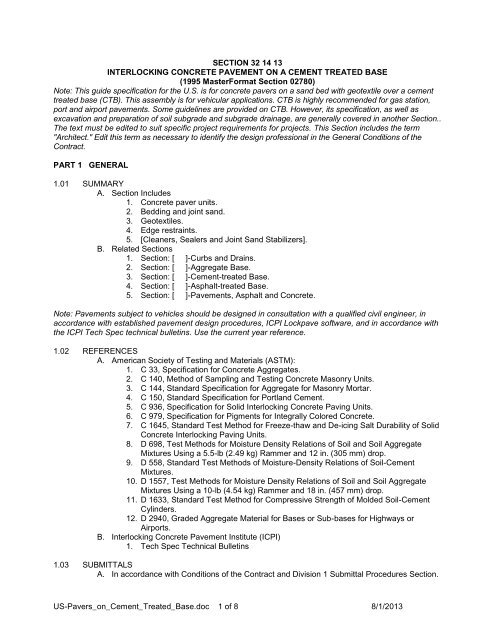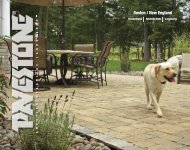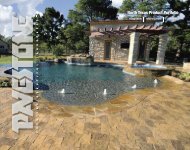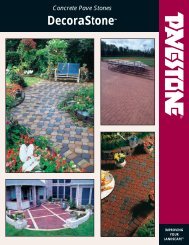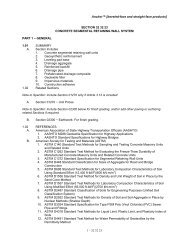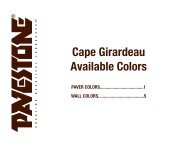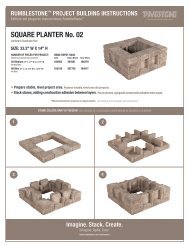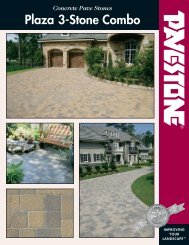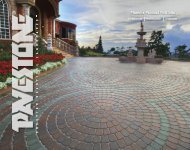Pavers on Cement Treated Base - Pavestone
Pavers on Cement Treated Base - Pavestone
Pavers on Cement Treated Base - Pavestone
You also want an ePaper? Increase the reach of your titles
YUMPU automatically turns print PDFs into web optimized ePapers that Google loves.
SECTION 32 14 13INTERLOCKING CONCRETE PAVEMENT ON A CEMENT TREATED BASE(1995 MasterFormat Secti<strong>on</strong> 02780)Note: This guide specificati<strong>on</strong> for the U.S. is for c<strong>on</strong>crete pavers <strong>on</strong> a sand bed with geotextile over a cementtreated base (CTB). This assembly is for vehicular applicati<strong>on</strong>s. CTB is highly recommended for gas stati<strong>on</strong>,port and airport pavements. Some guidelines are provided <strong>on</strong> CTB. However, its specificati<strong>on</strong>, as well asexcavati<strong>on</strong> and preparati<strong>on</strong> of soil subgrade and subgrade drainage, are generally covered in another Secti<strong>on</strong>..The text must be edited to suit specific project requirements for projects. This Secti<strong>on</strong> includes the term"Architect." Edit this term as necessary to identify the design professi<strong>on</strong>al in the General C<strong>on</strong>diti<strong>on</strong>s of theC<strong>on</strong>tract.PART 1 GENERAL1.01 SUMMARYA. Secti<strong>on</strong> Includes1. C<strong>on</strong>crete paver units.2. Bedding and joint sand.3. Geotextiles.4. Edge restraints.5. [Cleaners, Sealers and Joint Sand Stabilizers].B. Related Secti<strong>on</strong>s1. Secti<strong>on</strong>: [ ]-Curbs and Drains.2. Secti<strong>on</strong>: [ ]-Aggregate <strong>Base</strong>.3. Secti<strong>on</strong>: [ ]-<strong>Cement</strong>-treated <strong>Base</strong>.4. Secti<strong>on</strong>: [ ]-Asphalt-treated <strong>Base</strong>.5. Secti<strong>on</strong>: [ ]-Pavements, Asphalt and C<strong>on</strong>crete.Note: Pavements subject to vehicles should be designed in c<strong>on</strong>sultati<strong>on</strong> with a qualified civil engineer, inaccordance with established pavement design procedures, ICPI Lockpave software, and in accordance withthe ICPI Tech Spec technical bulletins. Use the current year reference.1.02 REFERENCESA. American Society of Testing and Materials (ASTM):1. C 33, Specificati<strong>on</strong> for C<strong>on</strong>crete Aggregates.2. C 140, Method of Sampling and Testing C<strong>on</strong>crete Mas<strong>on</strong>ry Units.3. C 144, Standard Specificati<strong>on</strong> for Aggregate for Mas<strong>on</strong>ry Mortar.4. C 150, Standard Specificati<strong>on</strong> for Portland <strong>Cement</strong>.5. C 936, Specificati<strong>on</strong> for Solid Interlocking C<strong>on</strong>crete Paving Units.6. C 979, Specificati<strong>on</strong> for Pigments for Integrally Colored C<strong>on</strong>crete.7. C 1645, Standard Test Method for Freeze-thaw and De-icing Salt Durability of SolidC<strong>on</strong>crete Interlocking Paving Units.8. D 698, Test Methods for Moisture Density Relati<strong>on</strong>s of Soil and Soil AggregateMixtures Using a 5.5-lb (2.49 kg) Rammer and 12 in. (305 mm) drop.9. D 558, Standard Test Methods of Moisture-Density Relati<strong>on</strong>s of Soil-<strong>Cement</strong>Mixtures.10. D 1557, Test Methods for Moisture Density Relati<strong>on</strong>s of Soil and Soil AggregateMixtures Using a 10-lb (4.54 kg) Rammer and 18 in. (457 mm) drop.11. D 1633, Standard Test Method for Compressive Strength of Molded Soil-<strong>Cement</strong>Cylinders.12. D 2940, Graded Aggregate Material for <strong>Base</strong>s or Sub-bases for Highways orAirports.B. Interlocking C<strong>on</strong>crete Pavement Institute (ICPI)1. Tech Spec Technical Bulletins1.03 SUBMITTALSA. In accordance with C<strong>on</strong>diti<strong>on</strong>s of the C<strong>on</strong>tract and Divisi<strong>on</strong> 1 Submittal Procedures Secti<strong>on</strong>.US-<str<strong>on</strong>g>Pavers</str<strong>on</strong>g>_<strong>on</strong>_<strong>Cement</strong>_<strong>Treated</strong>_<strong>Base</strong>.doc 1 of 8 8/1/2013
B. Manufacturer’s drawings and details: Indicate perimeter c<strong>on</strong>diti<strong>on</strong>s, relati<strong>on</strong>ship to adjoiningmaterials and assemblies, [expansi<strong>on</strong> and c<strong>on</strong>trol joints,] c<strong>on</strong>crete paver [layout,] [patterns,][color arrangement,] installati<strong>on</strong> [and setting] details.C. Sieve analysis per ASTM C 136 for grading of bedding and joint sand.D. [Test results for sand durability.]E. C<strong>on</strong>crete pavers:1. [Four] representative full-size samples of each paver type, thickness, color, finish thatindicate the range of color variati<strong>on</strong> and texture expected in the finished installati<strong>on</strong>.Color(s) selected by [Architect] [Engineer] [Landscape Architect] [Owner] frommanufacturer’s available colors.2. Accepted samples become the standard of acceptance for the work.3. Test results from an independent testing laboratory for compliance of paving unitrequirements to ASTM C 936.4. Manufacturer's catalog product data, installati<strong>on</strong> instructi<strong>on</strong>s, and material safetydata sheets for the safe handling of the specified materials and products.F. Paver Installati<strong>on</strong> Subc<strong>on</strong>tractor:1. A copy of Subc<strong>on</strong>tractor’s current certificate from the Interlocking C<strong>on</strong>cretePavement Institute C<strong>on</strong>crete Paver Installer Certificati<strong>on</strong> program.2. Job references from projects of a similar size and complexity. ProvideOwner/Client/General C<strong>on</strong>tractor names, postal address, ph<strong>on</strong>e, fax, and emailaddress.1.04 QUALITY ASSURANCEA. Paving Subc<strong>on</strong>tractor Qualificati<strong>on</strong>s:1. Utilize an installer having successfully completed c<strong>on</strong>crete paver installati<strong>on</strong> similarin design, material, and extent indicated <strong>on</strong> this project.2. Utilize an installer holding a current certificate from the Interlocking C<strong>on</strong>cretePavement Institute C<strong>on</strong>crete Paver Installer Certificati<strong>on</strong> program.B. Regulatory Requirements and Approvals: [Specify applicable licensing, b<strong>on</strong>ding or otherrequirements of regulatory agencies.].C. Mock-Ups:1. Install a 7 ft x 7 ft (2 x 2 m) paver area.2. Use this area to determine surcharge of the bedding sand layer, joint sizes, lines,laying pattern(s), color(s), and texture of the job.3. This area will be used as the standard by which the work will be judged.4. Subject to acceptance by owner, mock-up may be retained as part of finished work.5. If mock-up is not retained, remove and properly dispose of mock-up.1.05 DELIVERY, STORAGE & HANDLINGA. General: Comply with Divisi<strong>on</strong> 1 Product Requirement Secti<strong>on</strong>.B. Comply with manufacturer’s ordering instructi<strong>on</strong>s and lead-time requirements to avoidc<strong>on</strong>structi<strong>on</strong> delays.C. Delivery: Deliver materials in manufacturer’s original, unopened, undamaged c<strong>on</strong>tainerspackaging with identificati<strong>on</strong> labels intact.1. Coordinate delivery and paving schedule to minimize interference with normal useof buildings adjacent to paving.2. Deliver c<strong>on</strong>crete pavers to the site in steel banded, plastic banded or plasticwrapped packaging capable of transfer by fork lift or clamp lift.3. Unload pavers at job site in such a manner that no damage occurs to the product.D. Storage and Protecti<strong>on</strong>: Store materials protected such that they are kept free from mud,dirt, and other foreign materials. [Store c<strong>on</strong>crete paver cleaners and sealers permanufacturer’s instructi<strong>on</strong>s.]1. Cover bedding sand and joint sand with waterproof covering if needed to preventexposure to rainfall or removal by wind. Secure the covering in place.1.06 PROJECT/SITE CONDITIONSA. Envir<strong>on</strong>mental Requirements:US-<str<strong>on</strong>g>Pavers</str<strong>on</strong>g>_<strong>on</strong>_<strong>Cement</strong>_<strong>Treated</strong>_<strong>Base</strong>.doc 2 of 8 8/1/2013
1. Do not install sand or pavers during heavy rain or snowfall.2. Do not install sand and pavers over frozen CTB.3. Do not install frozen sand or saturated sand.4. Do not install c<strong>on</strong>crete pavers <strong>on</strong> frozen or saturated sand.1.07 MAINTENANCEA. Extra Materials: Provide [Specify area] [Specify percentage.] additi<strong>on</strong>al material for use byowner for maintenance and repair.B. <str<strong>on</strong>g>Pavers</str<strong>on</strong>g> shall be from the same producti<strong>on</strong> run as installed materials.PART 2 PRODUCTS2.01 CONCRETE PAVERSNote: C<strong>on</strong>crete pavers may have spacer bars <strong>on</strong> each unit. They are highly recommended for mechanicallyinstalled pavers. Manually installed pavers may be installed with or without spacer bars.A. Manufacturer: Pavest<strong>on</strong>e Company 800-245-7283.1. C<strong>on</strong>tact: [Specify Pavest<strong>on</strong>e representative’s name and ph<strong>on</strong>e number.].B. Interlocking C<strong>on</strong>crete <str<strong>on</strong>g>Pavers</str<strong>on</strong>g>:1. Paver Type: [Specify name of product group, family, series, etc.].a. Material Standard: Comply with material standards in ASTM C 936.b. Color [and finish]: [Specify color.] [Specify finish].c. Color Pigment Material Standard: Comply with ASTM C 979.d. Size: [Specify.] inches [({Specify.}mm)] x [Specify.] inches [({Specify.}mm)]x [Specify.] inches [({Specify.} mm)] thick.Note: If 3 1/8 in. (80 mm) thick pavers are specified, their compressive strength test results per ASTM C 140should be adjusted by multiplying by 1.18 to equate the results to that from 2 3/8 in. (60 mm) thick pavers.e. Average Compressive Strength (C 140): 8000 psi (55 MPa) with noindividual unit under 7200 psi (50 MPa).f. Average Water Absorpti<strong>on</strong> (ASTM C 140): 5% with no unit greater than 7%.g. Freeze/Thaw Resistance (ASTM C 1645): 28 freeze-thaw cycleswith no greater loss than 225 g/m 2 of paver surface area or no greater lossthan 500 g/m 2 of paver surface area after 49 freeze-thaw cycles. Freezethawtesting requirements shall be waived for applicati<strong>on</strong>s not exposed tofreezing c<strong>on</strong>diti<strong>on</strong>s.2.02 PRODUCT SUBSTITUTIONSA. Substituti<strong>on</strong>s: substituti<strong>on</strong>s to product specified will not be accepted after ten calendar daysprior to project bid date.2.03 BEDDING AND JOINT SANDA. Provide bedding and joint sand as follows:1. Washed, clean, n<strong>on</strong>-plastic, free from deleterious or foreign matter, symmetricallyshaped, natural or manufactured from crushed rock.2. Do not use limest<strong>on</strong>e screenings, st<strong>on</strong>e dust, or sand for the bedding sandmaterial that do not c<strong>on</strong>form to the grading requirements of ASTM C 33.3. Do not use mas<strong>on</strong> sand or sand c<strong>on</strong>forming to ASTM C 144 for the bedding sand.Note: Bedding sand durability is important for crosswalks and other vehicular pavements exposed to hightraffic, especially high truck traffic. ICPI Tech Spec 17 Bedding Sand Selecti<strong>on</strong> for Interlocking C<strong>on</strong>cretePavements in Vehicular Applicati<strong>on</strong>s recommends durability evaluati<strong>on</strong> using the Micro-Deval degradati<strong>on</strong>test per ASTM D7428. The maximum recommended loss is 8%. This ASTM test is recommended whenpavers and sand will be placed over c<strong>on</strong>crete, or asphalt, and subject to major thoroughfare traffic (over 1.5US-<str<strong>on</strong>g>Pavers</str<strong>on</strong>g>_<strong>on</strong>_<strong>Cement</strong>_<strong>Treated</strong>_<strong>Base</strong>.doc 3 of 8 8/1/2013
milli<strong>on</strong> lifetime 18,000 lb (80 kN) equivalent single axle loads or ESALs or a Caltrans Traffic Index of 9.5). Ifhigh traffic loads are anticipated and suitable bedding sand cannot be specified, the designer may c<strong>on</strong>siderusing bitumen-set (sand-asphalt) bedding layer under the pavers.4. Where c<strong>on</strong>crete pavers are subject to vehicular traffic, utilize sands that are as hardas practically available.5. Sieve according to ASTM C 136.6. Bedding Sand Material Requirements: C<strong>on</strong>form to the grading requirements ofASTM C 33 with modificati<strong>on</strong>s as shown in Table 1.Table 1ASTM C 33Grading Requirements for Bedding SandSieve Size Percent Passing3/8 in. (9.5 mm) 100No. 4 (4.75 mm) 95 to 100No. 8 (2.36 mm) 85 to 100No. 16 (1.18 mm) 50 to 85No. 30 (0.600 mm) 25 to 60No. 50 (0.300 mm) 10 to 30No. 100 (0.150 mm) 2 to 10No. 200 (0.075 mm) 0 to 1Note: Coarser sand than that specified in Table 2 below may be used for joint sand including C 33 or A23.1material as shown in Table 1. Use material where the largest sieve size easily enters the smallest joints. Forexample, if the smallest paver joints are 2 mm wide, use sand 2 mm and smaller in particle size. If C 33sand is used for joint sand, extra effort may be required in sweeping material and compacting the pavers inorder to completely fill the joints.7. Joint Sand Material Requirements: C<strong>on</strong>form to the grading requirements of ASTM C144 as shown with modificati<strong>on</strong>s in Table 2 below:Table 2ASTM C 144 Grading for Joint SandNatural SandManufactured SandSieve Size Percent Passing Percent PassingNo. 4 (4.75 mm) 100 100No. 8 (2.36 mm) 95 to 100 95 to 100No. 16 (1.18 mm) 70 to 100 70 to 100No. 30 (0.600 mm) 40 to 75 40 to 100No. 50 (0.300 mm) 10 to 35 20 to 40No. 100 (0.150 mm) 2 to 15 10 to 25No. 200 (0.075 mm) 0 to 1 0 to 10Note: Specify specific comp<strong>on</strong>ents of a system, manufactured unit or type of equipment. See ICPI TechSpec 3, Edge Restraints for Interlocking C<strong>on</strong>crete Pavements for guidance <strong>on</strong> selecti<strong>on</strong> and design of edgerestraints.2.04 EDGE RESTRAINTSA. Provide edge restraints installed around the perimeter of all interlocking c<strong>on</strong>crete paving unitareas as follows:1. Manufacturer: [Specify manufacturer.].2. Material: [Plastic] [C<strong>on</strong>crete] [Aluminum] [Steel] [Pre-cast c<strong>on</strong>crete] [Cut st<strong>on</strong>e][C<strong>on</strong>crete].3. Material Standard: [Specify material standard.].2.05 ACCESSORIESUS-<str<strong>on</strong>g>Pavers</str<strong>on</strong>g>_<strong>on</strong>_<strong>Cement</strong>_<strong>Treated</strong>_<strong>Base</strong>.doc 4 of 8 8/1/2013
A. Provide accessory materials as follows:1. Geotextile Fabric:a. Material Type and Descripti<strong>on</strong>: [Specify material type and descripti<strong>on</strong>.].b. Material Standard: [Specify material standard.].c. Manufacturer: [Acceptable to interlocking c<strong>on</strong>crete paver manufacturer][Specify manufacturer.].Note: Sealer for the purposes of joint stabilizati<strong>on</strong> are recommended for gas stati<strong>on</strong> and airfield applicati<strong>on</strong>s.Delete article below if cleaners, sealers, and/or joint sand stabilizers are not specified.2. [Cleaners] [Sealers] [Joint sand stabilizers]a. Material Type and Descripti<strong>on</strong>: [Specify material type and descripti<strong>on</strong>.].b. Material Standard: [Specify material standard.].c. Manufacturer: [Specify manufacturer.].Note: CTB is typically a mixture of portland cement Type I, ASTM C 150 and crushed coarse and fineaggregate c<strong>on</strong>forming to ASTM D 2940. The material should achieve a minimum compressive strength of4.5 MPa (650 psi) at seven days per ASTM D 1633. C<strong>on</strong>sult a qualified professi<strong>on</strong>al civil engineer formaterial, testing, and installati<strong>on</strong> specificati<strong>on</strong>s for CTB.PART 3 EXECUTIONNote: Subgrade preparati<strong>on</strong>, drainage, and installati<strong>on</strong> and/or rehabilitati<strong>on</strong> of subbase and CTB materialsmay be specified under other Secti<strong>on</strong>s. Some minimum requirements follow and a qualified civil engineershould be c<strong>on</strong>sulted for guidance in developing specificati<strong>on</strong>s for those Secti<strong>on</strong>s. Soil under CTB orsubbases should be free from deleterious material and compacted to a minimum of 98% Proctor densityaccording to ASTM D 698 or modified Proctor density per ASTM D1557 for heavily loaded industrial, portand airport pavements. Stabilizati<strong>on</strong> of the subgrade and/or base material may be necessary with weak orsaturated subgrade soils. A minimum 4 to 6 in. (100 to 150 mm) thick compacted aggregate sub-base underCTB is sometimes used as a working platform and is recommended. Compact aggregate subbase to aminimum of 98% modified Proctor density per ASTM 1557. CTB is typically applied in 4 in. (100 mm) liftsand compacted to a minimum of 96% density per ASTM D 558. Field measurements of density of soilsubgrade, subbases, and CTB should be reported in writing to the Engineer/Architect.Note: Mechanical tampers are recommended for compacti<strong>on</strong> of soil subgrade, sub-base and base aroundlamp standards, utility structures, building edges, curbs, tree wells and other protrusi<strong>on</strong>s. In areas notaccessible to roller compacti<strong>on</strong> equipment, compact to specified density with mechanical tampers.3.01 ACCEPTABLE INSTALLERSA. [Specify acceptable paving subc<strong>on</strong>tractors.].Note: The elevati<strong>on</strong>s and surface tolerance of the base determine the final surface elevati<strong>on</strong>s of c<strong>on</strong>cretepavers. The paver installati<strong>on</strong> c<strong>on</strong>tractor cannot correct deficiencies in the base surface with additi<strong>on</strong>albedding sand or by other means. Therefore, the surface elevati<strong>on</strong>s of the base should be checked andaccepted by the General C<strong>on</strong>tractor or designated party, with written certificati<strong>on</strong> to the pavingsubc<strong>on</strong>tractor, prior to placing bedding sand and c<strong>on</strong>crete pavers.3.02 EXAMINATIONA. Acceptance of Site Verificati<strong>on</strong> of C<strong>on</strong>diti<strong>on</strong>s:1. General C<strong>on</strong>tractor shall inspect, accept and certify in writing to the paverinstallati<strong>on</strong> subc<strong>on</strong>tractor that site c<strong>on</strong>diti<strong>on</strong>s meet specificati<strong>on</strong>s for the followingitems prior to installati<strong>on</strong> of interlocking c<strong>on</strong>crete pavers.a. Verify that subgrade preparati<strong>on</strong>, compacted density and elevati<strong>on</strong>sc<strong>on</strong>form to specified requirements.b. Verify that geotextiles, if applicable, have been placed according todrawings and specificati<strong>on</strong>s.US-<str<strong>on</strong>g>Pavers</str<strong>on</strong>g>_<strong>on</strong>_<strong>Cement</strong>_<strong>Treated</strong>_<strong>Base</strong>.doc 5 of 8 8/1/2013
c. Verify that [Aggregate] [<strong>Cement</strong>-treated] base materials, thickness,[compacted density], surface tolerances and elevati<strong>on</strong>s c<strong>on</strong>form to specifiedrequirements.d. Provide written density test results for soil subgrade, [aggregate] [cementtreated]base materials to the Owner, General C<strong>on</strong>tractor and paverinstallati<strong>on</strong> subc<strong>on</strong>tractor.e. Verify locati<strong>on</strong>, type, and elevati<strong>on</strong>s of edge restraints, [c<strong>on</strong>crete collarsaround] utility structures, and drainage holes and inlets.2. Do not proceed with installati<strong>on</strong> of bedding sand and interlocking c<strong>on</strong>crete paversuntil [subgrade soil and] base c<strong>on</strong>diti<strong>on</strong>s are corrected by the General C<strong>on</strong>tractor ordesignated subc<strong>on</strong>tractor.3.03 PREPARATIONA. Verify base is clean and dry, certified by General C<strong>on</strong>tractor as meeting material, installati<strong>on</strong>and grade specificati<strong>on</strong>s.B. Verify that base [and geotextile] is ready to support sand, [edge restraints,] and, pavers andimposed loads.C. Edge Restraint Preparati<strong>on</strong>:1. Install edge restraints per the drawings [and manufacturer’s recommendati<strong>on</strong>s] [atthe indicated elevati<strong>on</strong>s].Note: Retain the following two subparagraphs if specifying edge restraints staked into the base with spikes.2. Mount directly to finished base. Do not install <strong>on</strong> bedding sand.3. The minimum distance from the outside edge of the base to the spikes shall beequal to the thickness of the base.3.04 INSTALLATIONA. Spread bedding sand evenly over the base course and screed to a nominal 1 in. (25 mm)thickness. Spread bedding sand evenly over the base course and screed rails, using therails and/or edge restraints to produce a nominal 1 in. (25 mm) thickness, allowing forspecified variati<strong>on</strong> in the base surface.1. Do not disturb screeded sand.2. Screeded area shall not substantially exceed that which is covered by pavers in <strong>on</strong>eday.3. Do not use bedding sand to fill depressi<strong>on</strong>s in the base surface.Note: When initially placed <strong>on</strong> the bedding sand, manually installed pavers often touch each other, or theirspacer bars if present. Joint widths and lines (b<strong>on</strong>d lines) are straightened and aligned to specificati<strong>on</strong>s withrubber hammers and pry bars as paving proceeds.B. Lay pavers in pattern(s) shown <strong>on</strong> drawings. Place units hand tight without using hammers.Make horiz<strong>on</strong>tal adjustments to placement of laid pavers with rubber hammers as required.Note: C<strong>on</strong>tact manufacturer of interlocking c<strong>on</strong>crete paver units for recommended joint widths.C. Provide joints between pavers between [1/16 in. and 3/16 in. (2 and 5 mm)] wide. No morethan 5% of the joints shall exceed [1/4 in. (6 mm)] wide to achieve straight b<strong>on</strong>d lines.D. 1/2 in. (±15 mm) over 50 ft. (15 m) fromstring lines.E. Fill gaps at the edges of the paved area with cut pavers or edge units.F. Cut pavers to be placed al<strong>on</strong>g the edge with a [double blade paver splitter or] mas<strong>on</strong>ry saw.Note. Specify requirements for edge treatment in paragraph below.US-<str<strong>on</strong>g>Pavers</str<strong>on</strong>g>_<strong>on</strong>_<strong>Cement</strong>_<strong>Treated</strong>_<strong>Base</strong>.doc 6 of 8 8/1/2013
G. [Adjust b<strong>on</strong>d pattern at pavement edges such that cutting of edge pavers is minimized. Allcut pavers exposed to vehicular tires shall be no smaller than <strong>on</strong>e-third of a whole paver.][Cut pavers at edges as indicated <strong>on</strong> the drawings.]H. Keep skid steer and forklift equipment off newly laid pavers that have not received initialcompacti<strong>on</strong> and joint sand.I. Use a low-amplitude plate compactor capable of at least minimum of 4,000 lbf (18 kN) at afrequency of 75 to 100 Hz to vibrate the pavers into the sand. Remove any cracked ordamaged pavers and replace with new units.J. Simultaneously spread, sweep and compact dry joint sand into joints c<strong>on</strong>tinuously until full.This will require at least 4 to 6 passes with a plate compactor. Do not compact within 6 ft (2m) of unrestrained edges of paving units.K. All work within 6 ft. (2 m) of the laying face must shall be left fully compacted with sand-filledjoints at the end of each day or compacted up<strong>on</strong> acceptance of the work. Cover the layingface or any incomplete areas with plastic sheets overnight if not closed with cut andcompacted pavers with joint sand to prevent exposed bedding sand from becomingsaturated from rainfall.L. Remove excess sand from surface when installati<strong>on</strong> is complete.Note: Excess joint sand can remain <strong>on</strong> surface of pavers to aid in protecting their surface especially whenadditi<strong>on</strong>al c<strong>on</strong>structi<strong>on</strong> occurs after their installati<strong>on</strong>. If this is the case, delete the article above and use thearticle below. Designate pers<strong>on</strong> resp<strong>on</strong>sible for directing timing of removal of excess joint sand.M. Allow excess joint sand to remain <strong>on</strong> surface to protect pavers from damage from othertrades. Remove excess sand when directed by [Architect].N. Surface shall be broom clean after removal of excess joint sand.3.05 FIELD QUALITY CONTROLNote: Surface tolerances <strong>on</strong> flat slopes should be measured with a rigid straightedge. Tolerances <strong>on</strong>complex c<strong>on</strong>toured slopes should be measured with a flexible straightedge capable of c<strong>on</strong>forming to thecomplex curves <strong>on</strong> the pavement surface.A. 3/8 in. (±10mm) under a 10 ft (3 m) straightedge.B. Check final surface elevati<strong>on</strong>s for c<strong>on</strong>formance to drawings.Note: For installati<strong>on</strong>s <strong>on</strong> a compacted aggregate base and soil subgrade, the top surface of the pavers maybe 1/8 to 1/4 in. (3 to 6 mm) above the final elevati<strong>on</strong>s after compacti<strong>on</strong>. This helps compensate for possibleminor settling normal to pavements.C. The surface elevati<strong>on</strong> of pavers shall be 1/8 in. to 1/4 in. (3 to 6 mm) above adjacentdrainage inlets, c<strong>on</strong>crete collars or channels.D. Lippage: No greater than 1/8 in. (3 mm) difference in height between adjacent pavers.Note: Cleaning and sealing may be required for some applicati<strong>on</strong>s. See ICPI Tech Spec 5, Cleaning andSealing Interlocking C<strong>on</strong>crete Pavements for guidance <strong>on</strong> when to clean and seal the paver surface, andwhen to stabilize joint sand. Delete article below if cleaners, sealers, and or joint sand stabilizers are notapplied.3.06 [CLEANING] [SEALING] [JOINT SAND STABILIZATION]3.07 PROTECTIONA. [Clean] [Seal] [Apply joint sand stabilizati<strong>on</strong> materials between] c<strong>on</strong>crete pavers inaccordance with the manufacturer’s written recommendati<strong>on</strong>s.US-<str<strong>on</strong>g>Pavers</str<strong>on</strong>g>_<strong>on</strong>_<strong>Cement</strong>_<strong>Treated</strong>_<strong>Base</strong>.doc 7 of 8 8/1/2013
A. After work in this secti<strong>on</strong> is complete, the General C<strong>on</strong>tractor shall be resp<strong>on</strong>sible forprotecting work from damage due to subsequent c<strong>on</strong>structi<strong>on</strong> activity <strong>on</strong> the site.END OF SECTIONUS-<str<strong>on</strong>g>Pavers</str<strong>on</strong>g>_<strong>on</strong>_<strong>Cement</strong>_<strong>Treated</strong>_<strong>Base</strong>.doc 8 of 8 8/1/2013


